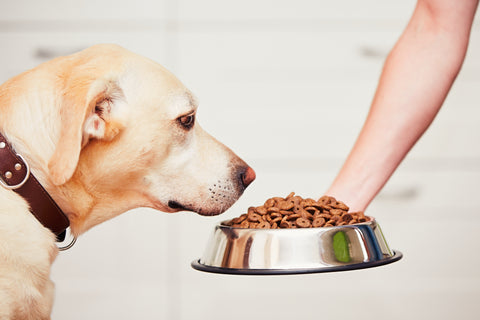

Posted by Marketing Team, on
A Guide to Pet Nutrition: Dogs
When it comes to feeding your dog, there is a whole host of options out there on the market. From raw dog food through to vet prescribed recipes, it's important to find the right balance and type of dog food to suit your dog's needs.
We've put together a guide on the different types of dog food available to help inform your choice, remember our in store nutritional experts are always on hand to help with any queries. If your dog suffers a severe reaction to any dog food- we always recommend seeking veterinary help as soon as possible.

Dog Food Categories
Dry Dog Foods
Dry complete foods, (kibble), are readily available, with the benefit being you do not need any preparation or storage requirements, and as such are extremely popular. Dry dog foods are made from dried and ground ingredients and can be cooked in several ways. The way a food is cooked can affect how digestible and palatable it is, along with determining how many essential vitamins remain intact through the process. In recent years, many dry dog food trends have been seen across a range of brands- from ingredients to cooking methods.
Dry dog food has many advantages as part of your dogs’ diet; it has a high energy content, longer shelf life and can be easily cleaned up after a messy mealtime.
Wet Dog Foods
Wet dog foods are also very popular, and can be found in tins, trays and pouches. Wet foods do not require any added preservatives, as the pasteurisation process kills all micro-organisms within the sealed containers. Wet foods can be complete or complementary. Since wet foods contain a large amount of water, the feeding amounts are much higher than those of dry foods, which often makes them more expensive to feed.
With a generally more intense smell and taste than dry food, a lot of dogs prefer wet dog food as part of their diet. Due to the higher water content, wet dog food can also help keep your dog hydrated- especially during summer.
Raw Dog Foods
Raw feeding is regarded by many as the most natural way to feed a dog or cat. Complete raw foods in the form of frozen blocks or nuggets, provide all of the benefits of raw feeding, with all the convenience of a conventional pet food. Like wet foods, there are both complete and complementary forms of raw foods, and raw foods inevitably contain a high proportion of water.
Types of Feeding
Complete Foods
In order to be 'complete', such foods must contain every nutrient required in sufficient amounts to keep your pet healthy, which means they can be fed alone. Complete foods can be dry, wet or raw.
Complementary Food
Such foods are to be added to another type of pet food to ensure your pet receives all its necessary nutrient requirements. An example of these are mixer biscuits which are low in protein but high in carbohydrates, so another food is needed to ensure that your pet receives the necessary protein requirements.
Mixers
Essentially cereal based filler biscuits, occasionally with vegetables or herbs. They are nutritionally incomplete and so must be fed alongside a wet or raw food. Like all pet foods, mixers range from very good quality to very poor.
Food Types (and what it means for your pet)
Wheat Free
Like us, our pets can be sensitive to wheat gluten. Wheat free pet foods are free from wheat gluten. Gluten is the protein that is found in specific types of grain, namely wheat, barley, and rye. Gluten free dog food is, of course, free of these proteins. However, not all grains contain gluten. Therefore, gluten free dog food may or may not be grain free, while grain free dog food will always be gluten free.
Grain Free
As the name suggests, grain free dog food recipes do not contain grains, such as wheat, barley, rice, oats, and rye. Grain free was designed to combat an increase in some dog’s allergic reactions to the grain that went into ordinary kibble.
Hypoallergenic
The term “hypoallergenic” is often used on pet food bags but it is not always clear what it means. As a word it means the lack of, or reduced number of, allergens likely to cause an immunological response.
Preservatives: Natural & Artificial
It has long been advised that pet parents do not feed dog/cat food that contains artificial preservatives such as butylated hydroxyanisole (BHA), butylated hydroxytoluene (BHT), tert-butyl hydroquinone (TBHQ), propyl gallate, and ethoxyquin, in favour of products made with natural preservatives, such as tocopherols (vitamin E), citric acid (vitamin C), and rosemary extract.
If you have any more questions about dog food options and the right nutrition for your pet, ask in store or submit a question online today.